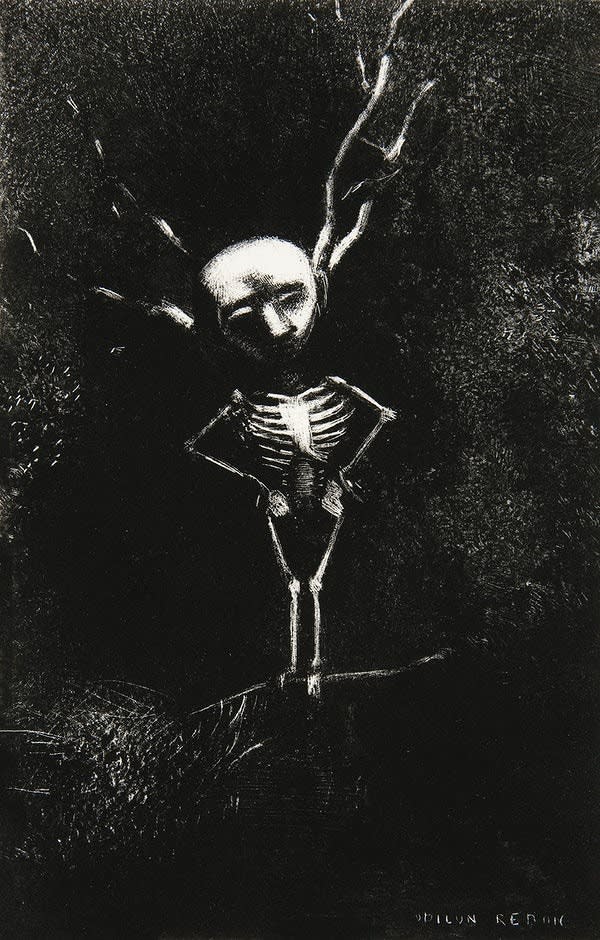
In the Maze of the Branches the Pale Figure Appeared, Odilion Redon, 1887
The 1955 film Kiss me Deadly, though not technically profound, was considered one of the rawest, distinctive, and heralded films of the film noir genre. The film is based on a book written by Mickey Spillane, one of the world's most prolific pulp fiction writers. Though there are additional films centered on the protagonist Mike Hammer, Kiss Me Deadly is a film based on a book of the same title. Hammer, the protagonist, is a violent, hardened all-American, good-guy detective. In this cinematic portrayal, he is demoted from a detective to a sleazy private eye investigating divorce cases. Mike Hammer's character is a more fascinating and solid contribution to this film, played by veteran Broadway actor turned Hollywood star Ralph Meeker. Meeker was not the author's first choice for the novel's adaptation, but nothing about the film intended to satisfy Spillane's vision.
I applaud Meeker's strategic portrayal of this character. Though Hammers' character had been played numerous times, Meeker turned him into a ruthless, violent anti-hero who descends into Los Angeles's underbelly. Meeker elevates the role by mirroring the atmospheric reality director Robert Aldrich created. He leans into the toxic masculinity of the period, caring more about his sports car than the safety of a half-naked woman running in the middle of the highway from the darkness. This portrayal is in stark contrast to the atomic family's ideal head as a husband, father, and provider. Meeker instead makes his way through a series of female co-stars, kissing them deadly.
Hammer begins to investigate what he believes is a twisted narcotics scheme, but the plot quickly devolves, and he finds himself falling into a nuclear apocalyptic rabbit hole. L.A.'s downtown district of Bunker Hill becomes a significant backdrop for Hammer's unraveling. Like classic film noir, the scenes are set in dank, dark alleys and buildings. His modern bachelor pad overlooks the haunted, soon-to-be-dead city, signifying that he and his efforts are above the law. Outside this film's context, this has
become archival footage of this area of L.A. because it was soon after razed to the ground.
The film was shot in three weeks. This short filming schedule resulted from a low budget, secured the film's place within the B category. Unfortunately, this did not always work to the film's advantage. Though Kiss Me Deadly is paced rather slowly, there are hints to the hastened production in numerous shots whereby the shadow of the camera is seen in the frame on the actors' bodies. Many of the film's sequences are long, without edits or multiple camera angles to cleverly reduce film use and editing time-- the 'boxing' or the 'drop the knife' scenes are good examples of this. These long takes also enhance the setting's apocalyptic milieu--there is a sense of lackluster hopelessness. The tonality of the black and white film seems flat or sharply contrasting, pointing to a lack of attention to lighting. When Hammer is followed in the 'drop the knife' scene, the cars' shadows are sharply silhouetted on a brick wall as if lit by only a single spotlight, which is most likely the case. The denial of the antagonist's facial features, which is only revealed at the end of the film, responds to the classic noir conventions.
The most masterful part of the film is in the first fifteen minutes. At night, a woman in the middle of the highway throws herself in front of Hammer's fast-approaching vehicle as if she has nothing to lose. The headlights blindly focus on the femme fatale, who immediately captures his thoughts and imagination. This scene is what opens a metaphorical and literal box into the unveiling of what Jim Emerson says to be "stark, hard-boiled cruelty, paranoia, insanity, and psychosexual angst." Following this intense opening sequence, the film credits unconventionally roll top to bottom in reverse order. Nat King Cole's song "I Rather Have the Blues" plays, which reflects the film's sardonic tone. The odd nature of the credits and the theme of a nuclear-driven dystopian world allows one to draw comparisons to The Twilight Zone TV series. This comparison is also evident in cast selection. Maxine Cooper, who plays Mike Hammer's secretary and one of his many love interests, made an appearance in season one, episode eleven of The Twilight Zone, 'And When the Sky Was Opened.'
Kiss Me Deadly gave birth to a new sci-fi-noir subgenre that provoked critics' antithetical reviews. This movie made space for films like Alphaville, directed by Jean-Luc Godard a decade later in 1965. The iconic still of actor Cloris Leachman who plays Christina Bailey, waving her hand in the middle of a highway at night only lit by car's headlights, may have inspired more contemporary films like David Lynch's Lost Highway. Some called Kiss Me Deadly a masterpiece; other critics found the film challenging for its 1955 audiences, due to its being so unconventional. However, this film has found a place within the American psyche and movie history, immortalized in popular culture as a film without a traditional Hollywood ending.
Maizy Shepherd is originally from Toronto, Canada. She is a senior in her final year studying Photo and Video at The School of Visual Arts. Shepherd has been featured in Canadian Art. She is a Hellen Van Meene Fotofilmic master class mentee. Her interests consist of publication, art writing, and pursuing a Master's degree in curatorial studies. She remains passionate about her work in a creative career. However, presently, she is excited to try new ventures being a waitress and making some money. Shepherd is delighted to be a part of it all!

